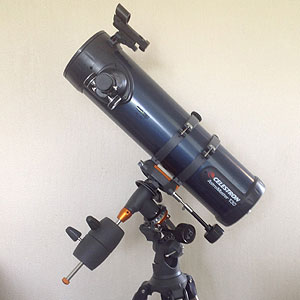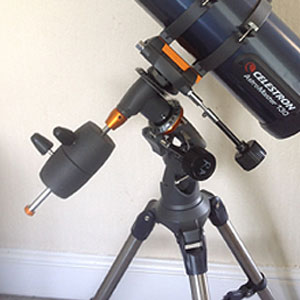Is the Celestron 130EQ a good Beginner Astronomy Telescope ?
16 May 2020 | Admin

I have always been interested in astronomy and the night sky but with a bit more time on my hands in lockdown I decided to get a bit more serious. That said I had no idea about telescopes and specifications, lenses, eyepieces etc so I looked around on the net and plenty of sites seemed to recommend Celestron as good beginner scopes. The 130eq seemed about the most powerful in the beginners price range that I was looking at and had good reviews for the quality of the optics and general build quality. It also seemed to be portable which many of the more powerful scopes aren't as the wight, length and bulk increases. As it can be used for daytime terrestrial viewing this is a plus point.
I looked on lots of different retailers and auction sites once I had identified the model I was interested in to compare prices but time and again PicStop couldn't be beaten. Their website was also good for a beginner. Lots of other sites seemed to assume that you already know loads of technical stuff about telescopes which made it more confusing. The buying process was really easy and the scope arrived well packaged.

The bulk of the telescope is taken up by the tube itself and the mount with a few smaller bits. The mount actually has a reassuring heft to it as you want something that is going to be stable in breezy Britain! To be honest the instructions from Celestron are a bit basic, I was expecting more of a booklet. The first thing that I was looking for was a picture of what it's supposed to look like when set up so that you know you were on the right track. I used the images on the PicStop website and a few YouTube videos and it all seemed fine. The instructions from Celestron are good enough when you back them up with a YouTube video or two. Actually attaching all the knobs, weights etc is quite easy and there's very little fiddly stuff. The two most complicated steps are balancing the scope and getting it polar aligned. The scope itself is really light, after all it's just a tube with mirrors but you have to balance it along the two axis to get a stable image. This was not too tricky but better to think about it before you start. Also, you need to balance the tube but Celestron make this easy as its quick and simple to open and secure the two bands that hold the scope. Once you've balance your scope you need to polar align it according to your latitude. You basically have to do this so that when you point it at something it appears. This was a simple enough process but again I needed YouTube help. What isn't in the instructions is that once you have it polar aligned you leave it there. The telescope doesn't move up and down but only along the RA and Declination axis which seems counterintuitive but is important to remember. I made several frustrating mistakes before realising this! Most of what I was concerned about was being too clumsy and damaging anything but the equatorial mount is really solid and forgiving for a beginner as is the tube though try not to bash it about obviously.
 My scope came with a laser dot finder so that you turn in the red dot and point it at something which then appears in the view. This HAS to be done in the DAY! I posted it a chimney down the road and basically you have to align the dot with the view, so they match and it seems to have worked pretty well. You want to do this several times on FIXED objects at different distances to make sure it's accurate. My other tip is when lining up to calibrate the telescope and laser or when looking at an object in the night sky use the RA and Declination controls to move the scope don't move the scope itself! This will help you learn how to use these which are the main controls that keep an object in view when you are looking at it and you have to constantly adjust them as you and objects are both moving. To be honest the only part of the scope that I could call flimsy are these controls. They attach by means of a metal screw that doesn't go through a hole but grips using friction. As its metal on metal they sometimes slip and I think it's a bit of a flaw on Celestron's part. As I've said before the more YouTube you watch before setting up the better! Once you've done all that you're good to go.
My scope came with a laser dot finder so that you turn in the red dot and point it at something which then appears in the view. This HAS to be done in the DAY! I posted it a chimney down the road and basically you have to align the dot with the view, so they match and it seems to have worked pretty well. You want to do this several times on FIXED objects at different distances to make sure it's accurate. My other tip is when lining up to calibrate the telescope and laser or when looking at an object in the night sky use the RA and Declination controls to move the scope don't move the scope itself! This will help you learn how to use these which are the main controls that keep an object in view when you are looking at it and you have to constantly adjust them as you and objects are both moving. To be honest the only part of the scope that I could call flimsy are these controls. They attach by means of a metal screw that doesn't go through a hole but grips using friction. As its metal on metal they sometimes slip and I think it's a bit of a flaw on Celestron's part. As I've said before the more YouTube you watch before setting up the better! Once you've done all that you're good to go.
I've found it easy enough to move inside and out though the mount is heavy and I've not detached the scope to move it which I will do when I go further afield. I received my scope in April and there were I initially some good clear nights. The brightest object in the sky was Venus which was in a crescent phase in the west and alas there was no moon until May. In addition to the scope I also purchased the Celestron eyepiece and filter kit which was as expensive as the scope. The eyepieces supplied with the scope are great but I would encourage anyone to get a Barlow lens as well. This increases the magnification on the lens. The 20mm lens is great as it has a wide field of view. It's important to remember that where the magnitude is expressed in my the higher the number the lower the magnitude. So a 6mm lens has more magnifying power than a 20 mm BUT the 20mm sees a larger portion of the sky which is good when you are trying to find small objects such as planets. This is when getting your laser finder accurate really helps! As I've got more practise it's become easier to use the smaller lenses and swap them quickly. Initially I think that the lens kit is probably more than a beginner needs especially as I've not got to grips with all the filters yet though I used the green one in the evening and got some good contrast on Venus. Also the Celestron instructions with the lenses are poor so back to YouTube I went. To be honest a 10mm, 20mm are probably sufficient for most needs but in May when the Moon the 6mm lens was superb! It felt like you could reach out and touch it! Overall there are more expensive lenses out there but I'd not want to spend any more as a beginner. I haven't looked at any deep sky objects yet as the weather has been a bit cloudy but I'm going to try and see the Crab Nebula and see what I can get. 
At the time of writing Mars, Jupiter, Uranus, Saturn and Neptune are below the horizon. I recommend getting a good guide to moon gazing as it the thing you'll see best and an app (there are good free ones available) as a guide. Celestron comes with its own software which I've not been able to access as I do t have a new enough version if IOS so a bit of a bummer. Also a planetarium as a guide to the constellations. In summary this is a great scope for the money for a beginner it just takes a little getting used to. Setup is quick and easy with a little help from online videos. There are accessories and I'm thinking of getting a mobile phone adapter to take pictures. I'd definitely use PicStop for this and when it comes to an upgrade!
Review by Ross Underwood
